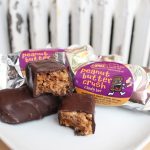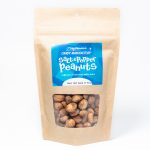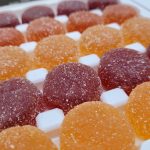Charlie explains what makes a great candy bar
Ari: Not all candy is the same. Most Americans have something of an emotional sweet/soft spot for all those commercial candies we grew up with. Is that commercial product really “great candy”?
Charlie: Marguerite Wildenhain once said, “A pot without a soul is just clay around a hole.” Candy—hard confectionary—is entering its renaissance. To be “great,” food needs to be crafted according to tradition and made with great ingredients. Candy made by the billions can’t be great. At the large companies, the focus is on mega profits alone. Their product has no soul. It is empty. Sweet, but otherwise flavorless. I think those Goliath corporations are banking a lot on nostalgia. All they can come up with now is more fancy packaging. Great candy can have fancy packaging, but fancy packaging does not make great candy. Tradition, taste and care all together equal great candy. Great candy should be inspiring. It should speak to you on many, many levels. Not just on a singular memory.
What is the difference between commercial candy and an artisan offering like what you make?
One is produced by a machine. The other is made with human hands guided by a creative and caring mind. It is mechanized profit versus craftsmanship. Artisanal candy has a lot more flavor going on. Our candy isn’t just sweet—it tastes good! The flavors deliver a lasting impression. The freshness delivers a great eating experience. Yes, it means putting in more time and effort and sourcing great ingredients like Charles Poirier’s cane syrup in the Poirier Poppers. He takes so much care crafting traditional cane syrup in Louisiana with a method that has been all but lost to mass production. But his labor pays off in the flavor of his syrup and then in the flavor of the candy we make with it.
Charles’ cane syrup IS amazing! He grows the cane, cuts the cane, mills it, and boils the juice himself to make the syrup. People can get the syrup at the Deli. But you’ve also been making incredible filled chocolate with it, the Poirier Poppers, and selling them at the Zingerman’s Coffee Company on Plaza Drive. Food writer John T. Edge tried them and said, “those Poirier bonbons . . . may be the best sweet burst of flavor I’ve ever tasted.”
Charles’ cane syrup is so good I really didn’t want to do anything more than “package” it in chocolate.
Zingerman’s Candy started out with the Zzang!® Candy Bar and that’s still sort of at the core of what you do. Tell us about those.
They’re all made by hand and, just as importantly, made to order. There aren’t tons of bars lying around waiting to be sold. When a retailer orders from us we start making the bars. I think very few people have ever had a fresh candy bar, but there’s a huge difference in flavor so we make all our candy to be sold fresh, not after months and months of sitting on a shelf.
I’ve rarely heard anyone talk about the importance of freshness in candy. It seems like the quiet secret of the candy world? What’s so different about it?
The flavors haven’t faded. The textures are what they are meant to be. Zzang!® bars were born in the pastry department of the Bakehouse where freshness is everything. Eating candy bars right off the line is a flavor experience not to be missed. We ship directly to our accounts so they can have it as fresh as possible. I haven’t found a single distributor willing to take us on because we don’t want our candy to be warehoused. At the Candy Manufactory, we do not use ingredients solely to extend shelf life or make a distributor’s job easy at the expense of flavor.
Can you walk folks through all the steps that go into making a Zzang!® Bar?
We start by toasting Jumbo Runner peanuts in fresh butter and sea salt until they’re golden brown. Then we start boiling cane sugar and Muscovado brown sugar for caramel, adding fresh butter and local heavy cream near the end. Then we beat egg whites and cook honey for the nougat to which we add peanut butter. All of that then gets layered into custom frames on small slabs. After setting for a day the new bars are dipped in 65% dark chocolate from Colombia. This bar we call The Original. It was the first flavor we did because I love each component. I’m constantly snacking on the peanuts, the caramel is truly divine, and chocolate is one of my food groups. The love comes with the sugar. You can do so many different things with it. In the nougat, it supports aeration created with the egg whites. In the caramel, it creates new flavors as it cooks. Every time it is a thrill.
How about the peanut brittle?
We start with plain white (purified) cane sugar and corn syrup. With higher cooking temperatures, we really can’t have impurities that would easily burn. We need the acidic syrup to counter the sugar’s strong desire to crystallize at the intense concentration we go to. Historically—like 150 years ago—we’d have to clarify the sugar and make the syrup ourselves. This boils in water, the water boils off, and the sugars—first broken apart in the water—now reorganize into new and complex compounds.
While the sugar is doing its thing, we add raw peanuts and some salt at a particular moment. The peanuts toast as the sugar caramelizes, and we arrive at a flavor meeting point for the two. They soak in this heated state briefly. Then we add butter, vanilla, baking soda, sea salt. What happens next has to be quick and deliberate. It’s dramatic. The foaming is fast and if you don’t get it out of the pot at the right moment it will overflow and be a dangerous mess. You really have to see it to believe it. Even though we are making brittle in relatively small batches, 23 pounds is a lot of really hot sugar to be stirring fast and safely.
Once it has spread out and cooled a bit we pull slightly hardened brittle off the edges. All the tiny bubbles produced by the reaction of the soda get elongated into tiny tubes. This is the structure we are after. It resembles a honeycomb. It is both fragile and strong in different ways. It is brittle. It shatters when bitten. I can get pretty poetic at this point, so do yourself a favor if you think you don’t like peanut brittle. I’ve gotten a lot of people turned on to it again. It is complex and simply delicious.
Let’s go back to those delicious little-filled chocolates you’ve been doing for the Coffee Company like the Poirier Poppers. You also have the Peanut Butter Crush and the Orange Oil chocolates, right?
I didn’t plan on any of those originally. When we started making candy I was asked about whether or not we were going to do them. My answer at the time was that a lot of other candy makers were already doing them well. But years down the road, Coffee Company Managing Partner Steve Mangigian asked if I’d consider making small chocolate to complement his espresso.
I adore orange butter ganache. You don’t often hear about butter ganaches, but I think their silkiness is elegant beyond belief, and the orange/chocolate combination is one of these match-made-in-heaven experiences. The Peanut Butter Crush has been a gift for my wife for many years. To get her off the “corporate cups” I began making her own version—just sweetened peanut butter in chocolate shells. The Poirier Poppers are an homage to Charles Poirier who makes that incredible cane syrup.
Zingerman’s businesses sell the most so their turnover is the fastest. They buy from us every week—sometimes more than once a week. We want a shopkeeper to have it as freshly made on their shelves as possible. And we date all our candy, so look for when it is best by. If you are in town and want to try one fresh off the line, call me.



